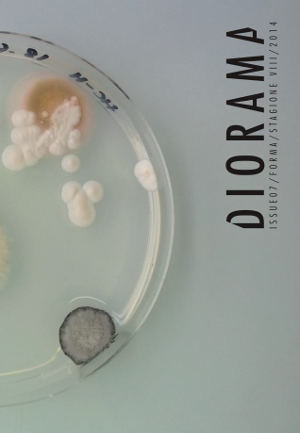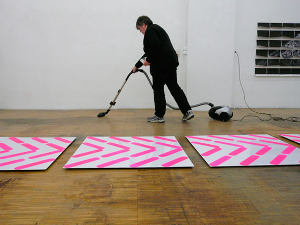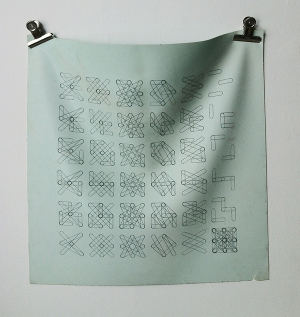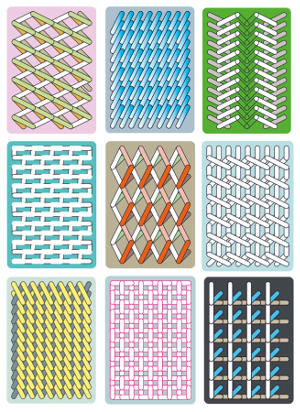L'edicola digitale delle riviste italiane di arte e cultura contemporanea
Diorama Mag Anno 4 Numero 7 primavera - estate 2014
Sigrid Calon
Zoe De Luca
Formal: total


02 / Vasa, Sculptures, 1979
04 / EDITORIALE
06 / WUNDERKAMMER
08 / INTRODUZIONE //Forma, Lorenza Novelli
10 / Ana Laura Alàez, Sade, Bilbao, 1999
12 / NATURALIA // Ginandromorfismo laterale, Zoe De Luca e Virginia Devoto
14 / FOCUS // Jenny Odell, Virginia Devoto e Jelena Miskin
18 / ARTE // Intervista a Sigrid Calon, Zoe De Luca
24 / F O C U S // The Wives Makers, Lorenza Novelli
28 / FOTOGRAFIA // Put Put, Zoe De Luca e Virginia Devoto
32 / ERBORITECA // Borsa pastore,Virginia Devoto e Alessandro Miroballo
34 / DINOSAURI // Carla Accardi, Eleonora Salvi
36/ LETTERATURA // L’obliquità dell’anatra, Samuele Fioravanti 40/ OGGETTO // Materia musicale, Zoe De Luca
42 / MODA? // Marcela Càrdenas, Taxonomía de fauna doméstica, 2011-2012
44 / Alessandro Mendini, Tea & Coffee Towers, 2003
48 / C I N E M A // La dissoluzione della forma nei titoli di testa, Anita Gazzani
52 / CINEMA // Recensioni
54 / MUSICA // Music into matter, Jelena Miskin
58 / MUSICA // Selezione musicale, Jelena Miskin
60 / ARTE // Digitale e sciolta, per piacere, Eleonora Salvi
66 / COMUNICAZIONE // Pittogrammi, Domenico Liberti
70 / ARTE? // Magical contamination, Zoe De Luca
74 / ENGLISH VERSION
84 / WUNDERKAMMER
86 / ABOUT
Interno Otolab
Virginia Devoto
n. 6 autunno-inverno 2013
A plunge in the Third Landscape
Eleonora Salvi
n. 5 primavera-estate 2013
Ogni sua parte somiglia all'intero
Virginia Devoto
n. 4 inverno 2013
Electronic Voice Phenomena
Jelena Miskin
n. 3 autunno 2012
The Rubber Man
Chiara Fraise Salvatori
n. 2 primavera-estate 2012
L’orizzonte è un continente
Alessandro Ciacci
n. 1 inverno 2012



Dutch artist Sigrid Calon builds her language out of pure and geometric pattern, interlacing graphics on every media, in any possible combination.
After an academic education and a design debut, she established herself as a visual artist; her work (almost ten year) is a continuous compositive exploration, conceptually complex, but always aesthetically minimal, and often ironic.
Her imaginary starts from the fascination for abstract embroidery: essence and search for identity emerge in various combinations, on multiple dimensional scales and often site-specifically.
A creative process of perpetual reformulation, where the stylistic coordinates are arranged, moved, challenged to materialize in the container that will host them, whether it be a square meter of fabric or the facade of a building. Branches out her work in different discipline, using different techniques: carving, silkscreen, knitting ... Yet she never loses sight of any fruition aspect: from the spatial scan to the tactile perception, Sigrid Calon meticulously keeps account of it all, thanks to a linear and mature vision and an almost artisanal approach.
Always guided by artistic and design awareness, shapes, colors and volumes are layered with rationality in a characteristic mood, looking for new connections and points of view even in the most apparently resolved monochromatic bidimension.
To close the circle there is the recent interest in publishing, which finds fulfillment in the publication of “To the extend of / | & - Within the grid and beyond the pattern “: the book , in parallel to the bidimension with Kaleid EditionsYoung Illustrators Award, brought her from Artbookfair of Basel, London, Berlin, Milan to institutions such as MoMA and the Victoria & Albert Museum founding considerable interest in the sector.
Zoe De Luca / In your work, shapes and patterns are analyzed through different crafts, from embroidery to computer process, exploring various techniques.You seem to have an artisanal attitude and education..
Sigrid Calon / I am very curious, I want to investigate, discover and create. That’s the beauty of life! I like to make new connections and to look differently at what we take for granted. I studied textiles and this was a kind of way we were reached; experimenting and trying was more important than the results. Nowadays I still like that most :-)
ZDL / Indeed, the publication “To the extend of / | &” is about your fascination for grids, that you explored through 120 RISO prints.What is the concept behind it?
SC / This work is based on a simple embroidery-grid (paper with holes in it). The concept is quite simple, but what you can do with it is superb.
I developed what I call my DNA; nine dots (3 x 3) and 8 lines (or possible ‘stitches’).
1 x horizontal
1 x vertical
1 x 45° to the right
1 x 45° to the left
1 x 26.5° to the right
1 x 26.5° to the left
1 x 63.5° to the right
1 x 63.5° to the left
When processed by the computer, the stitches become lines and new graphic possibilities arise:
Lines can be repeated or joined to form a longer line. Lines can be rendered with outline or without.
Lines can be reproduced as form or as in-between form. Lines and in-between forms can be put on top of one another in layers. To equal the intensity and craft of embroidery I used the stencilling technique. The RISO machine provides the quality of the screen printing process and is as practical in application as a photocopier.
I have chosen to work with 8 colors: fluorescent pink, blue, orange, brown, yellow, green, black and red.
As a consequence, this gave me the opportunity to go further than the standard CMYK.The color combinations have been the starting point for the book. 8 colors can generate 28 two-color combinations and 56 three-color combinations. Four-color combinations make 72 options appear.
Out of these I have made a selection of 28, so as to have a good basic combination of 4 compositions per A3. Each color combination in this book appears only once.The colors have been printed in layers and can be rendered in full tint or in a gradation of 0 up to 99%. Having chosen a grid, you can experience to the full how new colors come into being.
ZDL / Talking about the method behind all this, how do you deal with obsessions and then develop them into proper project forms?
SC / This is who I am, working with it, playing with it, searching until you find the ‘right’ one. This is pure intuitive.
Finding order and arranging the chaos. Searching for wonderment and beauty.
ZDL / As Lavoisier said, “In nature nothing is created, nothing is lost, everything changes”: nowadays, talking about formal and compositive research, what do you think about the link between endless experimentation and past influences?
SC / That’s the beauty of nature, it is how it is.We humans are creators, everything is created, everything has been considered. Even if we want to be ‘natural’, we have thought how to achieve that.“Everything changes” is what fascinates me. That’s also how the book arose, with a few ingredients you can do so many things: you can change it all the time, there is not one solution... Therefore I doesn’t imply that everything will lead to a good picture. In the end it’s also fulfilling to create something that will remain for a long(er) time.
ZDL /You also smoothly switch between different scales, from postcards to building facades,
always keeping your action totally congruent... How did you enhance a such solid visual sign through the years?
SC / Just by doing and practicing...Try as long until you are really satisfied and try to go for your instinct, that’s very important. Over the years you are developing your instinct and you can rely on it more and more. I love to think big, but also appreciate small things and details.
ZDL / So, what are the projects that satisfied you the most?
SC / I am very happy with the book, it is the result of years and all came together and finds his place. It probably will become a key-work. But I have to say, that most projects I worked on were very satisfying, because I always try to make the best out of it. I love very much “OCCUPIED SPACE IV” because it was the first time that I went three dimensional and it worked so well in that specific building. But also the old prison in Turin, a site-specific-installation I made last year is special to me. And of course the “LACEhouse”: my first house, even if it was only visible (in real) for a couple of months, it is still on my retina. Sometimes you have a very good idea, but the circumstances do not work with it at that time. For example the sketch for “MU”, unfortunately it stayed a sketch. Who knows, maybe there will come another opportunity for that work, another time another place.
Is there any experience in particular that you would point out to meditate
on creativity and vision?
SC / When I was invited in 2008 as a guest of “STORMLICHT”, an artist-in-residence-project, I felt so privileged. It was so good to take some time off and take time to reflect and react on new possibilities.There were no specific results needed in those two months, no pressure, nothing, I could afford to make mistakes. But at the end you feel so rich with just the experience and numerous (strange) tests.
ZDL / As a visual artist, you often work on assignments: how did you face collaborations’ compromises and expectancy?
SC / That is something I had to learn.After graduating the art academy, I had no clue what to do. And certainly not regarding my autonomous work! So I tried to do some commercial work that seemed ‘nice’ and where I could earn some money. The first 5 years I did a lot of styling and designing for a dutch fashion brand, got a lot of freedom and worked with a many nice people.
The work was quite varied so it was very educational for me.After a while the work became real work and the deadlines were getting faster, I was getting more resistance against that system. I felt it was time to take another path, but still did not know exactly what. Meanwhile, I became a mother and were (unintentionally) a few years out of the running. After those ‘lost’ years it was time to take some action!
The feeling to develop myself artistically was bigger than ever, so I needed to do what was necessary; no more jobs with lots of compromises or expectations in the wrong directions. Since I was so focused on my own work, it took all my time and energy to create something good. I did a lot of ‘assignments’ for free or very little money, just because I was convinced that I could make interesting new work.
I am so happy that I made that decision, because now when people or organizations ask for an assignment or for a collaboration, it’s because of my work and the way I see it!

